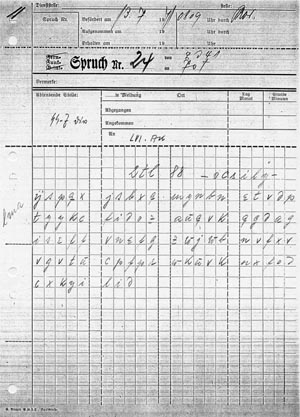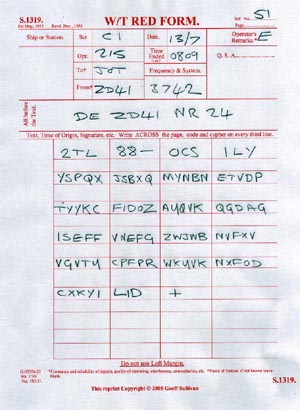

message form.
message form.
193?
Steckered Enigma machine adopted by the German army.
Wheels used: Umkehrwalze A (reflector) and wheels I, II, III. Messages used a fixed daily
Grundstellung to double encipher each message key.
The message header would contain two trigrams which is the double enciphered message key enciphered
using the daily Grundstellung (message key was keyed in twice).
1932
Late 1932 Polish Cryptanalyst Marian Rejewski recovers
the entire machine wiring by mathematical analysis using a group of intercepts and machine settings
for two months, September and October 1932, supplied by the French.
1937
On 2nd November Umkehrwalze B was introduced,
replacing Umkehrwalze A and this remained in use until the end of the war in 1945.
1938
On September 15th the fixed daily Grundstellung
was dropped. Each message must now have a different Grundstellung selected by the operator.
The message header would contain three trigrams, the Grundstellung followed by the double
enciphered message key enciphered using the message Grundstellung.
1938
On 15th December wheels IV and V were added. Three wheels
could now be selected from a set of five — giving 60 possible arrangements. A different wheel arrangement
could now be used for every day of the month. The two additional wheel wirings were quickly recovered
by Rejewski.
1939
On 1st January the number of plugboard connections was
increased from six to ten.
1940
The First Welchman-Turing Bombe enters service in March.
1940
On 1st May the double enciphered message key was dropped.
The Message key was only enciphered once from now on. The message header would contain two trigrams,
the message Grundstellung followed by the enciphered message key.
A sample test message using the 1940 procedure:
Wheel Order II I IV (2 1 4) Ringstellung CAS Steckers AG CH EP JX LZ NR OQ SV TW UY Selected Grundstellung SCA Message key enciphered at this Grundstellung ZHR Message: 1645 - 40 - SCA ZHR - MKINZ FZBWZ FEGRJ CPSAR BHCGB EQJFH AJIPV OMEZL ar sk
(Set up the machine as above, Set the wheels to SCA. Type in ZHR. Note which three lamps light up. Set these three lamp letters on the wheels and type in the 40 letter message).
Message lengths were strictly limited to a maximum of 250 letters, or fifty groups of five - there were only fifty cipher group boxes on the pre-printed message forms. Messages longer than 250 letters were split into two or more parts. Something like this may be used:
0824 - 2tle - 1tl - 244 - PGS YJZ - UPXBW BDFUD LBNXZ XAZQA ....... 0824 - 2tl - 233 - JDR IGU AMXNL TONVD GDLSV WKOLD .....
This is a two part (2 teile) message composed of part 1 (1 teil) of 244 letters and part 2 (2 teil) of 233 letters. The time of origin of the message is 0824 hours.
There were many variations to the Enigma procedures in the Army, Air Force and Navy.
Air Force (Luftwaffe) messages usually included a message number in the message header.
Most networks also used a Kenngruppe. This was a three or more letter indication used
to identify a cipher network and hence tell the receiver which key-sheet was used to encipher
the message. The Kenngruppe usually consisted of three letters taken from a list of
daily settings, four for each day. These three letters were arranged in random order and preceded
by two dummy letters. This group of five, sent in clear, would form the first group of the message. Another variation was to include the group of three letters with the message indicator.
The Kenngruppe was later dropped from some networks, since it gave away information about the networks and identified messages on the same key.
Naval Enigma used an entirely different procedure.
 |
 |
| German Enigma operator's message form. | Reconstructed Intercept Operator's message form. |
Copyright:
All rights to the material described on these
pages belong to
Geoff Sullivan & Frode Weierud,
© March 2006
 Back to Frode’s CryptoCellar
Back to Frode’s CryptoCellar
|
Site visitors: |